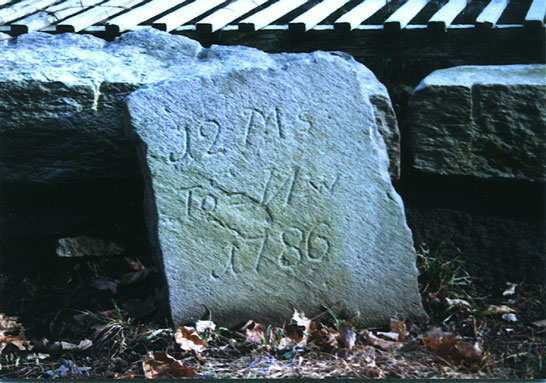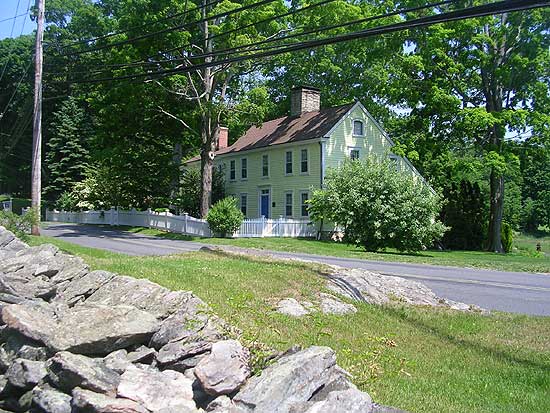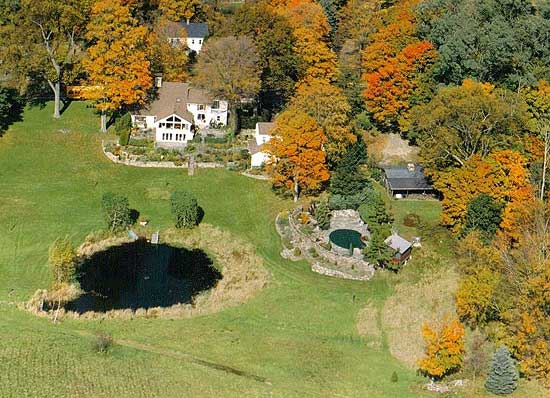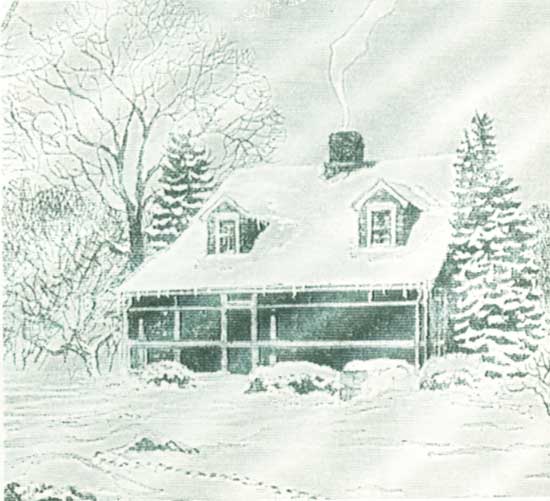|
What
home in Redding, CT is the oldest, and still-standing?
Is a question I am asked quite often. I asked Charley Couch,
Redding Town Historian and former president of the Redding
Historical Society, for assitance.
Below
is the information Charley provided. It is a very truthful
and honest answer...not to mention very interesting. Thank
you Charley!
"I
don't think anyone really knows which is the oldest house
in Redding since not all of the antiques have been checked
out.
According
to RHS files, Bob Beecroft's house on Black Rock Turnpike
dates from 1709. The house is originally a two-room design
more common in the 17th century and rare after 1700 as an
architectural type. (see the history of this house at the
Mark Twain Library)
The
Aaron Barlow house (on the corner of Umpawaug and Station
Rd.) is also very old (at least 1724) and may be older. It
may be associated with the Nathan Gold 300 Acre Farm that
was established between 1667 and 1687 there at "Umpawaug Neck."
The
Morehouse Farm was also in this vicinity prior to 1700.
Nearby
at 657 Redding Rd. is another very old house that I researched
and dates to ca. 1727 through John Sanford but it may have
been built earlier by the Gold Family.
The
New Pond Farm house may be from this period too but requires
more research.
The
Capt. Thos. Nash saltbox house at 175 Umpawaug Rd. dates from
1725-26. This is in keeping with the construction style and
building orientation seen at the two white saltboxes further
down the road near Wayside Lane. One belonged to Ebba Anderson
and was totally renovated a few years ago.
David
Heald's house at 32 Black Rock is an early raised-Cape style
and may date prior to 1730.
The
small 1 1/2-story saltbox on Pine Tree Rd. likely dates from
the period too.
The
"Cradle of Methodism" you alluded to was not built by Aaron
Sanford's father, but rather Gurden Marchant Sr. prior to
1750. The house at 60 Cross Highway was once owned by him
too and although it was heavily updated in the 1840's and
the original two-room layout suggests a very old and primitive
structure was the core of it.
In
the Center of Redding, Larry Ford's house dates from around
1750.
Please
note: There are even more house mysteries to be discovered
but as you can see, trying to say which may be the "oldest"
is an elusive matter.
List
of Select Older Homes in Redding
House:
McCready House
Street: 169 Gallows Hill Road
Date: 1770
House:
Gershom Morehouse
Street: 42 Cross Highway
Date: 1744
House:
Coley-Henkel House
Street: 14 Fox Run Road
Date: 1749
House:
Sanford House
Street: 140 Black Rock Tpke.
Date: 1755
House:
Meeker Ewing House
Street: 3 Great Pasture Road
Date: 1760
House:
Ephraim Sanford House
Street: 17 Giles Hill Road
Date: 1767
House:
Abel Morehouse House
Street: 230 Poverty Hollow Road
Date: 1768
House:
Lee Cartoun House
Street: 42 Wayside Lane
Date: 1770
House:
Simon Couch House
Street: 12 Old Redding Road
Date: 1773
House:
Ephraim Wheeler Jr. House
Street: 23 Giles Hill Road
Date: 1775
House:
Eli Sanford House 1
Street: 155 Topstone Road
Date: 1784
House:
Parsons Harris House
Street: 74 Wayside Lane
Date: 1788
House:
Beers-Hingle-Hart House
Street: 15 Lonetown Road
Date: 1789
House:
Mead-Sigurdsson House
Street: 11 Gallows Hill Road
Date: 1789
House:
Aaron Morehouse
Street: 35 Lonetown Road
Date: 1790
House:
Ezekiel Jackson House
Street: 187 Umpawaug Hill Road
Date: 1790
House:
Gershom Beers House
Street: 123 Black Rock Tpke.
Date: 1791
House:
Crofoot-Goodsell House
Street: 73 Stepney Road
Date: 1791
House:
Lemuel Lyon House
Street: 23 Giles Hill Road
Date: 1792
See
whole list with owners (opens in new window)
.
Do
you own or are you looking to own an older home?
If
you truly are looking for an older home in Redding you should
view the Margaret Wixted Collection at the Mark Twain Library.
It has house histories, family histories, photos new and old.
What
is available at the Mark Twain Library

Historic
Homes For Sale in Redding:
William
Pitt Real Estate- Agent
Ginny Beasley
470 Main
Street
Ridgefield, CT 06877
Agent Phn:
203-482-4938
Ginny
Beasley
Old
Tavern/Stage Coach Stop
For
many years, the location of this antique was known as "Boston
Corners". It was on an Post Road/Stage Coach route which
ran from New York to Boston. It was the place where the horses
were changed and passengers were fed. The house has been renovated
over these years, however an old post road milestone still
sits on the west side of the house...which is rare. This tavern
had a number of owners which resulted in several name changes
for the corner on which it sits: Boston Corners, Pinckney's
Corner, and Darling's Corner are the most common. View
House History.

Milestone
reads: "12 Ms (miles) To= Nw (Norwalk) 1786" *it
was 12 miles to Danbury as well.
William
Pitt Real Estate- Agent
Ginny Beasley
470 Main
Street
Ridgefield, CT 06877
Agent Phn:
203-482-4938
Ginny
Beasley
Landmark
Antique on Cross Highway
The
main residence is a 1753 landmark colonial offering nine gracious
rooms of grand proportion and comfort on 21.58 acres. This
four bedroom, 4 1/2 bath residence is in excellent condition
and boasts six fireplaces, wide floorboards, rich moldings,
exposed beams and classic New England charm galore.


The orientation of the home is outside to the exceptional
stone patios, extensive gardens, sprawling lawns, pond, gunite
pool with screen house and commanding rolling field views
of which 15 1/2 acres are preserved in perpetuity by a conservation
easement. The outbuildings include a 46 x 28 fully restored
barn, an artist studio and separate two-bedroom apartment
over the detached garages and a rustic two-bedroom log cabin.
Truly an Extraordinary Opportunity! $2,200,000. View
slideshow of the Landmark Antique on Cross Highway.
A
Glimpse of Old Redding Homes by Florence H. Whiting
The ReddingTimes Feb. 25, 1960
Florence
H. Whiting, Feb. 25, 1960:
Our
proud, little town will be 200 years young in 1967. In our
35 square mile area, the backbone of Redding was created.
Beginning
our tour on the Ridge, heading north on route 58, (Black Roack
Road) a weather-beaten salt box, the Bradley Kelly's home,
will attract your attention. Its lean-to greenhouse is one
of many modernizations. It was constructed about 1735 and
believed to have been built by Andrew Burr, who was a petitioner
establishing Redding as a recognized town in Connecticut.

Kelly
House
A
mile northward we will pass "The Spinning Wheel"
another Burr Homestead, owned by Bradley Burr, who had the
mail route by stagecoach from Newtown to Norwalk. Other generations
of Burrs lived here. A part of the original building was destroyed
by fire in 1948, but old Bradley Burr's portrait still hangs
over the fireplace mantel.
Another
mile further north will bring you to the "Old Red House",
circa 1740, restored and now owned by Miss Madeline McCue.
This was the old "Redding Institute" for boys, established
in 1847 by Daniel Sanford, later the Redding Ridge Post Office.
The Zenke Colonial across the road was also part of the Institute,
owned then by Professor Edward J. Shaw, who taught foreign
languages and literature. Shaw had the school until 1873,
when he became Probate Judge of Redding. He also was the grandfather
of our beloved Annie Banks.
Redding
Spy Ring
Opposite
Christ Episcopal Church is a weathered, twin-chimneyed Colonial,
now owned by the Dysons, circa 1746, and built by Stephen
Betts as a tavern for coach stops. During the American Revolution,
Captain Betts with William Heron, a neighbor, and General
Parsons, who lived there during the troops' stay at Putnam
Park, together formed a unique spy ring for General George
Washington. This spy ring proved so successful that General
Tryon of the British army tried to capture Captain Betts,
who escaped by a concelaed staircase to the cellar of his
home and on horseback sped through the "Hollow"
to Newtown. Later he was captured and imprisoned in New York.
Cradle
of Methodism
Driving
west on Cross Highway, there is a large weathered Salt Box
built by Hezekiah Sanford for his son, Aaron, circa 1736.
This is truly the "museum" of Redding, still unspoiled
and furnished with exquisite antiques. It is now owned by
Herbert Greenes. Jesse Lee, the Methodist Circuit Rider preached
sermons here. Later Bishop amesbury from England helped to
establish the first Methodist meeting house in New England
here. The first male member to join the Methodist doctrine
was Aaron Sanford, who became a staunch leader. In a photostat
copy of a document written by Aaron Sanford granting freedom
to his two slaves, after he heard the Lord speaking to him
advising him to mend his ways.
The
Green
Overlooking
the "Green", where the Revolutionary soldiers trained,
stands the Ritter house, circa 1736. A wing of this house
was the first town market, later removed. A portion of the
second floor was used for town meetings, where a hinged partition
was swung up ans secured by a huge hook, while a log burning
fireplace kept the gatherings warm.
On
the north side of the "Green", stands the Deacon
Thaddeus M. Abbott's home, now the Edmond's place. Abbott
was a blacksmith and specialized in building sleighs. Deacon
Abbott worked diligently for the Congregational Church. North
of the old Town Hall is the Will Roland home. It was built
by Stephen Burr, uncle of Aaron Burr who fought a duel with
Alexander Hamilton. Stephen Burr supervised the laying out
of the first road in Redding from Chestnut Ridge and Fairfield
town in 1734. Burr also laid the stone foundation of the new
Congregational Church in 1732. He had charge of the first
parsonage and was instrumental in securing the first parson.
Burr had his own grist mill.
West
of the center "Green", on Cross Highway, is an unusually
fine, unspoiled Salt Box owned by Bart Sanford. This house
was built by skilled workers hired by Rev. Nathaniel Bartlett,
who had purchased the land in 1753 from Lemuel Sanford for
800 pounds. Upon its completion he brought his bride here
and became the second pastor of the Congregational Church.
Rev. Bartlett secretly stored ammunitions in the attic to
protect the town, hoping the British wouldn't discover it.
West
Redding Homes
Located
in West Redding on Umpawaug and Station Road is the Hutchinson
home. It is a pure Salt Box, built in 1730, the very first
house to be constructed in Redding after the early settlers'
cabins. This house was built by Benjamin Meeker, and later
occupied by his son, Witely Meeker. * Important Note:
[from
a historical sketch by Margaret Wixed this house was presumably
built by Joseph Sanford: Joseph had married Catherine Fairchild
in 1724. His first son, Nehemiah, was born in 1725. His other
children were Elnathan, Phoebe, Ann, Timothy, Joseph, Nathan
and Stephen. In 1773, Nehemiah was living in the house
on Station Road, which presumably had been built by his father,
Joseph. That year, he sold the house and farm to Aaron Barlow,
a brother of Joel Barlow, the author and statesman. Year's
later: David Starr 2nd sold 174 acres to Isaac Meeker,
who now owned the Barlow Farm on Station Road. (Aaron
Barlow had died of yellow fever in Norfolk. Virginia in 1880.)
A map from 1867 of Redding has a W.Meeker at this house
and a J. Meeker Store across the street. B.Colley 2002]
The
Livermore home on Marchant Road, is the finest cut stone,
Colonial home in Fairfield County. It was built by Gurdon
Marchant for his bride in 1747. The stone was brought from
Topstone Mountain and squared and surfaced painstakingly.
Marchant was our first Redding Town Treasurer, and also helped
in planning the town roads. My favorite story is that when
Gurdon Marchant was buried, dressed in his Sunday suit, the
members of his family returned home to discover that his wallet
was missing. They dug him up to find it in his suit. [M.Wixted
Noted: A direct descendant of Gurdon Merchant, who came to
town from California in the summer of 1997 in search of her
ancestors, helped clear up the mistake about Marchant Road.
The name was misspelled in the town records. B.Colley 2002]
The
Aspidorf Salt Box on Diamond Hill Road was the second home
built in 1730. It was known as the Boughton homestead, bought
in later years and restored by Albert Bigelow Paine, Mark
Twain's biographer. Inside there are two columns separation
two rooms came from Mark Twain's home, obtained after the
Clemens' home "Stormfield" was destroyed by fire.
List
of Old Homes in Redding and Their Past Owners (Word
Document) forwarded by Jean Taylor.
Homes
on the National Register of Historic Places in Georgetown,
CT
William
Pitt Real Estate- Agent
Ginny Beasley
470 Main
Street
Ridgefield, CT 06877
Agent Phn:
203-482-4938
Ginny
Beasley
Page
Sponsored by:
Douglas C. Kenley Plumbing, Heating and Air-Conditioning.
Plumbing, Heating and
Air Conditioning products & services
here in Fairfield County and in Litchfield County
Back to TOP
| Back to Redding Section | Back
to Georgetown Section
|

